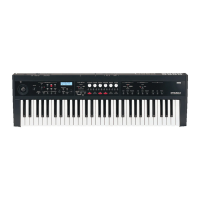En-12
Using controllers
In addition to its keyboard, the PS60 lets you control the sound using various controllers such as the joystick
and button, or an optional damper pedal, foot switch or foot pedal.
Keyboard and keyboard settings
Velocity, keyboard tracking, and portamento
The sound can be affected by the strength or speed (velocity) at
which you strike a key, and can also change depending on the
keyboard position (keyboard tracking).
For example, changing the speed (i.e., force) at which you strike a
key will affect the sound’s loudness and brightness. Notes played
higher on the keyboard will typically be brighter and will decay
more quickly. This is the same response of an acoustic piano
which you may already be familiar with. Since the
PS60
lets you
reverse these settings or combine them in various ways, you are free to create entirely different effects.
Portamento is an effect you have probably heard when listening to the sound of a monophonic analog syn-
thesizer; it makes the pitch change smoothly from one note to the next, and is highly distinctive of synthesiz-
ers ( OM p. 30).
In addition to these, the PS60’s front panel provides octave and transpose buttons that let you instantly shift
the pitch in steps of one octave or transpose it by semitones.
Joystick
You can modify the sound by moving the joy-
stick up/down/left/right. For many of the pre-
load programs, left/right movement will change
the pitch, upward movement will apply vibrato,
and downward movement will apply a wah
effect. However, there are many other programs
that have different assignments of their own.
Joystick Lock function
When you release the joystick, it will automati-
cally return to the center position, and the effect
will disappear. However by pressing the LOCK
button (making the indicator light) while the effect is being applied, you can make the
effect continue even after you release the joystick.
Note: You can use the Global mode Controllers - JS Lock setting to specify the direction
(X or Y) for which the Lock function will apply. (Default: +/–Y) ( OM p. 47)
Example: How velocity affects the volume
Softly played Strongly played
Volume
Time Time
Volume
Octave
The pitch that is actually played when you
strike a note can be shifted in one-octave
steps by pressing these buttons. Use them
when you run out of range on the keyboard.
The octave buttons let you shift the pitch in a
range of +/–3 octaves.
Note: This will change the settings of the
PS60’s keyboard. Even if you switch perfor-
mances or timbre programs, the Octave set-
ting will remain unchanged.
Transpose
The pitch that is actually played when you strike a note can be
shifted in semitone steps by pressing these buttons.
The transpose buttons let you shift the pitch in a range of +/–1
octave (12 semitones).
By using these buttons to transpose the keyboard, you can play a
song at a pitch that’s more comfortable for a vocalist or another
instrument, while using the fingering that’s familiar to you.
Note: This will change the settings of the PS60’s keyboard. Even
if you switch performances or timbre programs, the Transpose
setting will remain unchanged.
Pitch is
lowered
(–X)
Vibrato effect (+Y)
Pitch is
raised
(+X)
Filter LFO (–Y)

